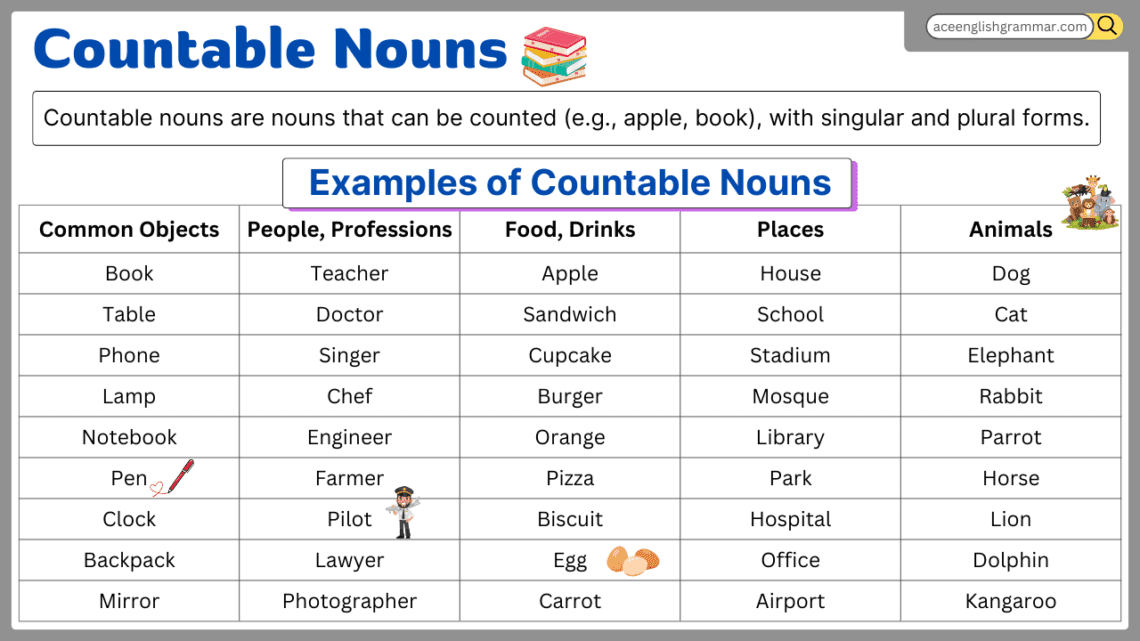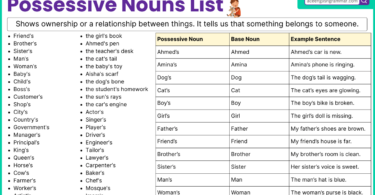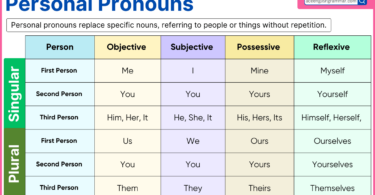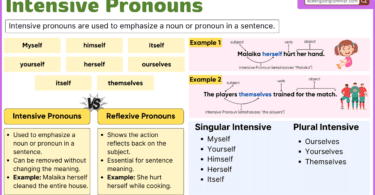Countable nouns are a fundamental aspect of grammar, allowing us to express quantity and differentiate between singular and plural forms. These nouns can be used with numbers and specific quantifiers, making them essential for clear and accurate communication. Many English learners struggle with making sentences correctly because they are unsure when to use articles like a and an or how to pluralize words properly. This confusion can lead to grammatical errors and misunderstandings. Mastering countable nouns helps learners construct correct sentences and avoid these common mistakes. Learn the definition, rules, and examples of countable nouns, along with their usage in sentences.
Table of Contents
Definition of Countable Noun
A countable noun is a noun that refers to things that can be counted individually, such as “apple,” “book,” or “chair.” It has both singular and plural forms.
- Book – We can say one book, two books, three books, etc.
- Chair – She bought four chairs for the dining room.
Examples of Countable Nouns
Learning countable nouns helps you use correct singular/plural forms and numbers in sentences. They have both singular and plural forms and can be used with numbers (one apple, two chairs). It improves your accuracy in speaking and writing English.
| Category | Description | Examples |
|---|---|---|
| Common Objects | Everyday items that can be counted. | Chair, Table, Phone, Lamp, Door |
| People & Professions | Nouns referring to individuals and job roles. | Teacher, Doctor, Singer, Chef, Artist |
| Food & Drinks | Solid foods and packaged drinks that are countable. | Apple, Sandwich, Cupcake, Bottle of juice |
| Places | Specific locations that exist as separate units. | House, School, Stadium, Restaurant, Mosque |
| Animals | Living creatures that can be counted. | Dog, Cat, Elephant, Rabbit, Parrot |
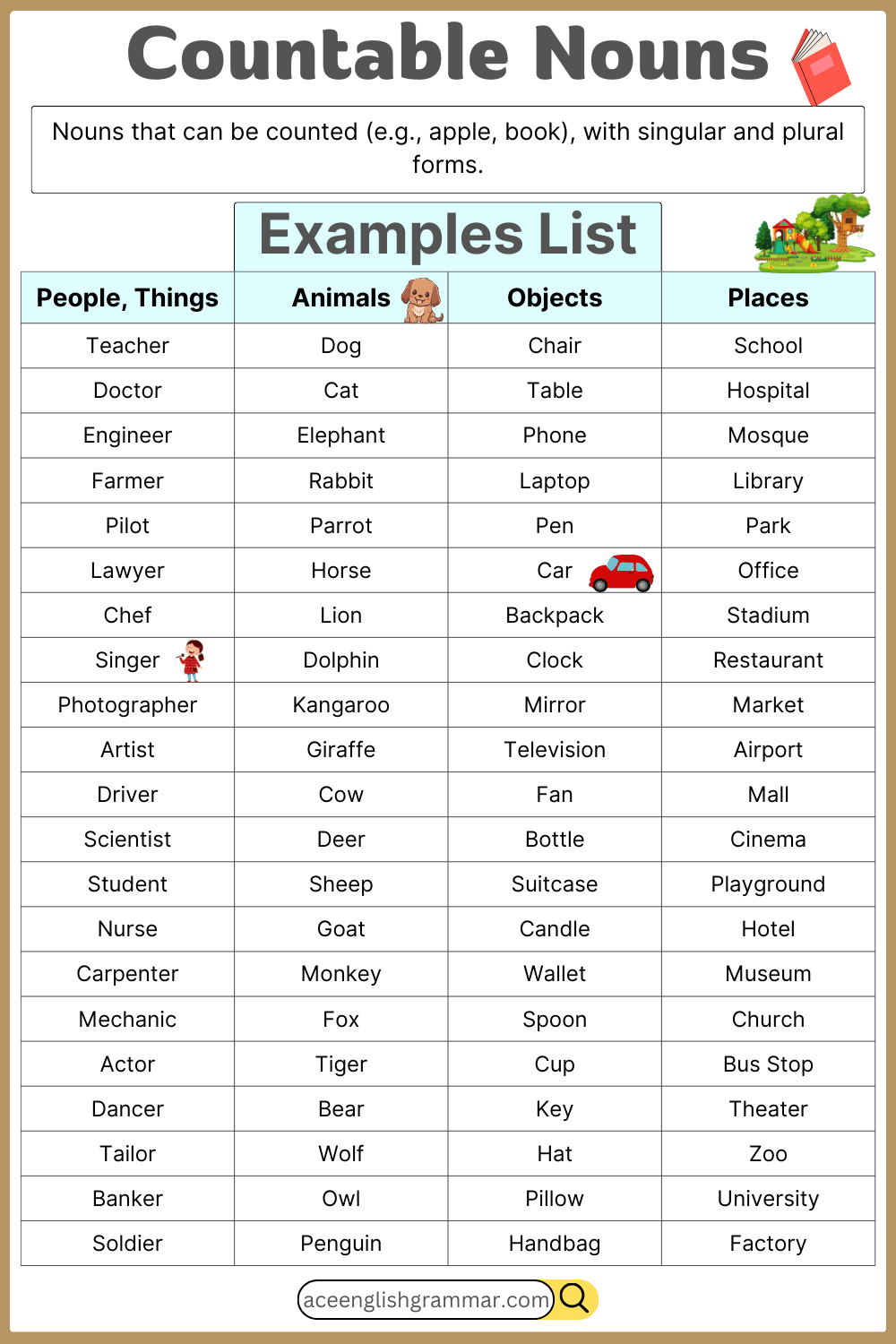
Rules for Countable Nouns
To use countable nouns correctly, follow these important rules: They can be singular or plural, so use “a” or “an” with singular forms and add “s” or “es” for plurals. They also work with numbers and quantity words like “many,” “few,” and “several.”
- Singular and Plural Forms:
- Singular countable nouns must have an article (a/an) or a determiner (this, that, my, his).
- Plural countable nouns do not require an article.
- ✅ A cat is sitting on the chair.
- ✅ There are three cats in the garden.
- Use with Numbers:
- Countable nouns can be used with numbers to indicate quantity.
- ✅ I have two pens and five notebooks.
- Use with Quantifiers:
- We can use words like many, few, several, and a number of with countable nouns.
- ✅ There are many students in the class.
- ✅ I have a few books on my shelf.
- Use in Questions and Negatives:
- In questions and negative sentences, we commonly use any and many.
- ✅ Do you have any pens?
- ✅ She doesn’t have many friends.
- Pluralizing Countable Nouns:
- Most countable nouns form their plural by adding “-s” or “-es”.
- ✅ One box → two boxes, one bus → three buses.
- Some have irregular plurals, such as child → children, man → men.
Countable Nouns List
Countable nouns are words that represent things we can count, such as books, apples, or chairs. They have both singular and plural forms.
| Singular | Plural |
|---|---|
| Apple | Apples |
| Banana | Bananas |
| Chair | Chairs |
| Table | Tables |
| Pen | Pens |
| Pencil | Pencils |
| Book | Books |
| Notebook | Notebooks |
| Bottle | Bottles |
| Cup | Cups |
| Door | Doors |
| Window | Windows |
| House | Houses |
| Apartment | Apartments |
| Car | Cars |
| Bicycle | Bicycles |
| Bus | Buses |
| Train | Trains |
| Shoe | Shoes |
| Shirt | Shirts |
| Bag | Bags |
| Suitcase | Suitcases |
| Lamp | Lamps |
| Candle | Candles |
| Ticket | Tickets |
| Passport | Passports |
| Camera | Cameras |
| Microphone | Microphones |
| Ball | Balls |
| Bat | Bats |
| Mirror | Mirrors |
| Painting | Painting |
Using Countable Noun in Sentences
- With Singular and Plural Forms:
- The teacher explained the lesson clearly.
The noun teacher is countable, as we can say one teacher, two teachers, etc. - I bought three apples from the market.
Here, apples is countable because we can count them individually.
- The teacher explained the lesson clearly.
- With Quantifiers:
- There are many chairs in the room. The noun chairs is countable and used with many.
- She has a few good friends. The noun friends is countable and used with a few to indicate a small number.
- With Articles:
- I saw a dog in the park. The noun dog is singular and countable, so we use a before it.
- The students are in the classroom. Here, students is plural and does not need an article.
Difference Between Countable and Uncountable Nouns
Key differences between countable and uncountable nouns with examples:
| Feature | Countable Nouns | Uncountable Nouns |
|---|---|---|
| Definition | Nouns that can be counted as individual items. | Nouns that cannot be counted as separate items. |
| Singular & Plural | Have both singular and plural forms (e.g., book/books). | Usually have only a singular form (e.g., water, advice). |
| Use with Numbers | Can be used with numbers (one apple, two chairs). | Cannot be used with numbers directly (not: two water). |
| Articles (a/an) | Can use a/an (a car, an apple). | Cannot use a/an (not: an information). |
| Quantifiers | Use many, a few, several (many books, a few pens). | Use much, a little, some (much rice, a little sugar). |
| Examples | Table, chair, book, apple, dog, car. | Water, sugar, furniture, advice, knowledge, music. |
Why Should You Learn Countable Noun?
Learning countable noun helps you use correct grammar, like singular/plural forms and articles (a, an, the). It improves speaking, writing, and understanding English accurately.
- It helps in constructing grammatically correct sentences.
- It improves both written and spoken English proficiency.
- It enhances clarity in communication by indicating exact quantities.
- It aids in the proper use of articles (a, an, the) and quantifiers (some, many, few).
FAQs
Things that we can count (e.g., apple, book), with singular and plural forms.
A noun is countable if you can add a number before it and make it plural. For example, one apple, two apples; one chair, three chairs. If a noun does not have a plural form (like water or advice), it is uncountable.
Yes. Some is used in positive sentences (e.g., I have some books), while many is used to indicate a large number in both questions and negatives (e.g., Do you have many friends? She doesn’t have many apples).
Countable nouns refer to things that can be counted individually (chair, book, car), while uncountable nouns refer to things that cannot be counted (water, rice, information). Countable nouns have plural forms, whereas uncountable nouns do not.
Using an uncountable noun as countable: ❌ I have three advices. ✅ I have three pieces of advice.
Forgetting articles in singular form: ❌ I saw cat in the garden. ✅ I saw a cat in the garden.
Download PDF
To make learning easier, we have compiled a detailed list of countable nouns along with their descriptions and examples in a PDF format. This downloadable PDF will help you understand countable noun better and serve as a quick reference for study or teaching purposes.
Conclusion
Countable nouns play a vital role in English grammar by allowing us to express quantity and differentiate between singular and plural forms. Learning these nouns enhances writing and speaking accuracy, helping learners construct clear and grammatically correct sentences. By understanding the rules, examples, and common mistakes, English learners can use countable nouns effectively in everyday conversations and academic writing.
Read More

